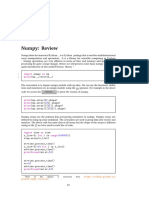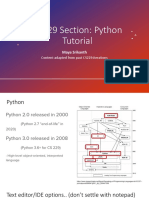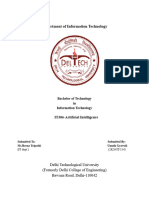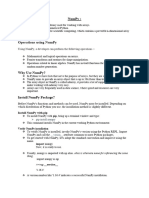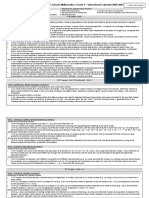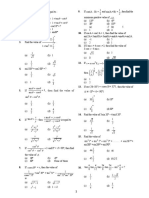Week 2 Exercise 03 - NumPy Operations
Uploaded by
ellinejcruzWeek 2 Exercise 03 - NumPy Operations
Uploaded by
ellinejcruzCS158-1L: Artificial Intelligence Laboratory
Week 2 Exercise 03 - NumPy Operations
Name: Cruz, Elline Joyce Score
:
Sectio C5 Date: 06/17
n:
Objectives:
● Understand the programming fundamentals and the Python language.
● Write Python programs that utilize variables, data types, and operators.
Instructions:
1. To complete this exercise, please follow the sample commands in Python provided to
you. Once you have completed the assignment, please submit the IPython file and
this document to me. You have one week to complete the exercise from the assigned
date. Please let me know if you have any questions or concerns regarding the
assignment.
2. When submitting your completed assignment, please name the IPython file as
follows: "surname_firstname_MP1Exercise". Replace "surname" with your last name,
"firstname" with your first name, and "MP2Exercise" with the name of the machine
problem.
For example, if your name is John Smith and the machine problem is
"PythonExercise2", the file name should be "smith_john_PythonExercise1.ipynb".
Please adhere to this naming convention when submitting your file. This will ensure I
can quickly identify your submission and provide appropriate feedback.
Prepared by: Raymond Sedilla, Mapua University
CS158-1L: Artificial Intelligence Laboratory
Week 2 Exercise 03 - NumPy Operations
Arithmetic: You can easily perform array with array arithmetic, or scalar
with array arithmetic.
In [1] import numpy as np
arr = np.arange(0,10)
arr
Out[1] array([0, 1, 2, 3, 4, 5, 6, 7, 8, 9])
In [2] arr + arr
Out[2] arr+arr
array([ 0, 2, 4, 6, 8, 10, 12, 14, 16, 18])
In [3] arr * arr
Out[3] array([ 0, 1, 4, 9, 16, 25, 36, 49, 64, 81])
In [4] arr - arr
Out[4] array([0, 0, 0, 0, 0, 0, 0, 0, 0, 0])
In [5] # This will raise a Warning on division by zero, but not an error!
# It just fills the spot with nan
arr/arr
Out[5] array([nan, 1., 1., 1., 1., 1., 1., 1., 1., 1.])
In [6] # Also a warning (but not an error) relating to infinity
1/arr
Out[6] array([ inf, 1. , 0.5 , 0.33333333, 0.25 ,
0.2 , 0.16666667, 0.14285714, 0.125 , 0.11111111])
In [7] arr**3
Out[7] array([ 0, 1, 8, 27, 64, 125, 216, 343, 512, 729], dtype=int32)
Prepared by: Raymond Sedilla, Mapua University
CS158-1L: Artificial Intelligence Laboratory
Week 2 Exercise 03 - NumPy Operations
Universal Array Functions: NumPy comes with many universal array
functions, or ufuncs, which are essentially just mathematical operations that
can be applied across the array.
In [8] # Taking Square Roots
np.sqrt(arr)
Out[8] array([0. , 1. , 1.41421356, 1.73205081, 2. ,
2.23606798, 2.44948974, 2.64575131, 2.82842712, 3. ])
In [9] # Calculating exponential (e^)
np.exp(arr)
Out[9] array([1.00000000e+00, 2.71828183e+00, 7.38905610e+00,
2.00855369e+01,
5.45981500e+01, 1.48413159e+02, 4.03428793e+02,
1.09663316e+03,
2.98095799e+03, 8.10308393e+03])
In [10] # Trigonometric Functions like sine
np.sin(arr)
Out[10] array([ 0. , 0.84147098, 0.90929743, 0.14112001, -0.7568025 ,
-0.95892427, -0.2794155 , 0.6569866 , 0.98935825, 0.41211849])
In [11] # Taking the Natural Logarithm
np.log(arr)
Out[11] array([ -inf, 0. , 0.69314718, 1.09861229, 1.38629436,
1.60943791, 1.79175947, 1.94591015, 2.07944154, 2.19722458])
Summary Statistics on Arrays: NumPy also offers common statistics like sum,
mean, and max.
In [12] arr = np.arange(0,10)
arr
Out[12] array([0, 1, 2, 3, 4, 5, 6, 7, 8, 9])
In [13] arr.sum()
Out[13] 45
Prepared by: Raymond Sedilla, Mapua University
CS158-1L: Artificial Intelligence Laboratory
Week 2 Exercise 03 - NumPy Operations
In [14] arr.mean()
Out[14] 4.5
In [15] arr.max()
Out[15] 9
Axis Logic: When working with 2-dimensional arrays (matrices) we have to
consider rows and columns. This becomes very important when we get to the
section on pandas. In array terms, axis 0 (zero) is the vertical axis (rows),
and axis 1 is the horizontal axis (columns). These values (0,1) correspond to
the order in which arr. shape values are returned.
In [16] arr_2d = np.array([[1,2,3,4],[5,6,7,8],[9,10,11,12]])
arr_2d
Out[16] array([[ 1, 2, 3, 4],
[ 5, 6, 7, 8],
[ 9, 10, 11, 12]])
In [17] arr_2d.sum(axis=0)
Out[17] array([15, 18, 21, 24])
In [18] arr_2d.shape
Out[18] (3, 4)
Prepared by: Raymond Sedilla, Mapua University
You might also like
- Billones_SebastanLuise_Week 2 Exercise 03 - NumPy OperationsNo ratings yetBillones_SebastanLuise_Week 2 Exercise 03 - NumPy Operations4 pages
- Week 2 Exercise 02 - NumPy Indexing and SelectionNo ratings yetWeek 2 Exercise 02 - NumPy Indexing and Selection5 pages
- MP2 Exercise 02 - NumPy Indexing and SelectionNo ratings yetMP2 Exercise 02 - NumPy Indexing and Selection4 pages
- Fundamentals of Data science Lab manual newNo ratings yetFundamentals of Data science Lab manual new33 pages
- Fundamentals of Data Science Lab ManualNo ratings yetFundamentals of Data Science Lab Manual34 pages
- A Selection of Useful Numpy Core Functions: Greg Von WinckelNo ratings yetA Selection of Useful Numpy Core Functions: Greg Von Winckel14 pages
- CS229 Section: Python Tutorial: Maya SrikanthNo ratings yetCS229 Section: Python Tutorial: Maya Srikanth39 pages
- vertopal.com_C1_W1_Lab_1_introduction_to_numpy_arraysNo ratings yetvertopal.com_C1_W1_Lab_1_introduction_to_numpy_arrays12 pages
- Gwinnett County Public Schools Mathematics: Grade 4 - Instructional Calendar 2020-2021No ratings yetGwinnett County Public Schools Mathematics: Grade 4 - Instructional Calendar 2020-20213 pages
- Digital Image Processing (CS/ECE 545) Lecture 4: Filters (Part 2) & Edges and ContoursNo ratings yetDigital Image Processing (CS/ECE 545) Lecture 4: Filters (Part 2) & Edges and Contours74 pages
- VIDYA SAGAR ABC Analysis For CA Foundation BMRS For Dec 2021No ratings yetVIDYA SAGAR ABC Analysis For CA Foundation BMRS For Dec 20213 pages
- CJC JC 2 H2 Maths 2011 Mid Year Exam QuestionsNo ratings yetCJC JC 2 H2 Maths 2011 Mid Year Exam Questions5 pages
- maths-class-x-chapter-08-09-trigonometry-practice-paper-08No ratings yetmaths-class-x-chapter-08-09-trigonometry-practice-paper-084 pages
- Profit Maximization in A Product Mix Company Using Linear ProgrammingNo ratings yetProfit Maximization in A Product Mix Company Using Linear Programming6 pages
- School of Risk and Actuarial Studies - UG - StudentNo ratings yetSchool of Risk and Actuarial Studies - UG - Student1 page
- Galois Theory Without Abstract Algebra PDFNo ratings yetGalois Theory Without Abstract Algebra PDF35 pages
- Comparison of Simple - and Piso-Type Algorithms For Transient FlowsNo ratings yetComparison of Simple - and Piso-Type Algorithms For Transient Flows25 pages
- Intellectual Revolution That Define SocietyNo ratings yetIntellectual Revolution That Define Society9 pages
- Understanding Array by DK Mamonai 09CE37No ratings yetUnderstanding Array by DK Mamonai 09CE3717 pages
- Time-Domain Approach To Microwave Circuit Modeling: View General Relations Between TLM and FDTD (Invited Article)No ratings yetTime-Domain Approach To Microwave Circuit Modeling: View General Relations Between TLM and FDTD (Invited Article)11 pages
- PDF Measures Integrals and Martingales 2Nd Edition Ren L Schilling Ebook Full Chapter100% (2)PDF Measures Integrals and Martingales 2Nd Edition Ren L Schilling Ebook Full Chapter42 pages
- 6 Different Ways To Compensate For Missing Values in A DatasetNo ratings yet6 Different Ways To Compensate For Missing Values in A Dataset6 pages
- Billones_SebastanLuise_Week 2 Exercise 03 - NumPy OperationsBillones_SebastanLuise_Week 2 Exercise 03 - NumPy Operations
- A Selection of Useful Numpy Core Functions: Greg Von WinckelA Selection of Useful Numpy Core Functions: Greg Von Winckel
- vertopal.com_C1_W1_Lab_1_introduction_to_numpy_arraysvertopal.com_C1_W1_Lab_1_introduction_to_numpy_arrays
- Gwinnett County Public Schools Mathematics: Grade 4 - Instructional Calendar 2020-2021Gwinnett County Public Schools Mathematics: Grade 4 - Instructional Calendar 2020-2021
- Digital Image Processing (CS/ECE 545) Lecture 4: Filters (Part 2) & Edges and ContoursDigital Image Processing (CS/ECE 545) Lecture 4: Filters (Part 2) & Edges and Contours
- VIDYA SAGAR ABC Analysis For CA Foundation BMRS For Dec 2021VIDYA SAGAR ABC Analysis For CA Foundation BMRS For Dec 2021
- maths-class-x-chapter-08-09-trigonometry-practice-paper-08maths-class-x-chapter-08-09-trigonometry-practice-paper-08
- Profit Maximization in A Product Mix Company Using Linear ProgrammingProfit Maximization in A Product Mix Company Using Linear Programming
- School of Risk and Actuarial Studies - UG - StudentSchool of Risk and Actuarial Studies - UG - Student
- Comparison of Simple - and Piso-Type Algorithms For Transient FlowsComparison of Simple - and Piso-Type Algorithms For Transient Flows
- Time-Domain Approach To Microwave Circuit Modeling: View General Relations Between TLM and FDTD (Invited Article)Time-Domain Approach To Microwave Circuit Modeling: View General Relations Between TLM and FDTD (Invited Article)
- PDF Measures Integrals and Martingales 2Nd Edition Ren L Schilling Ebook Full ChapterPDF Measures Integrals and Martingales 2Nd Edition Ren L Schilling Ebook Full Chapter
- 6 Different Ways To Compensate For Missing Values in A Dataset6 Different Ways To Compensate For Missing Values in A Dataset



























